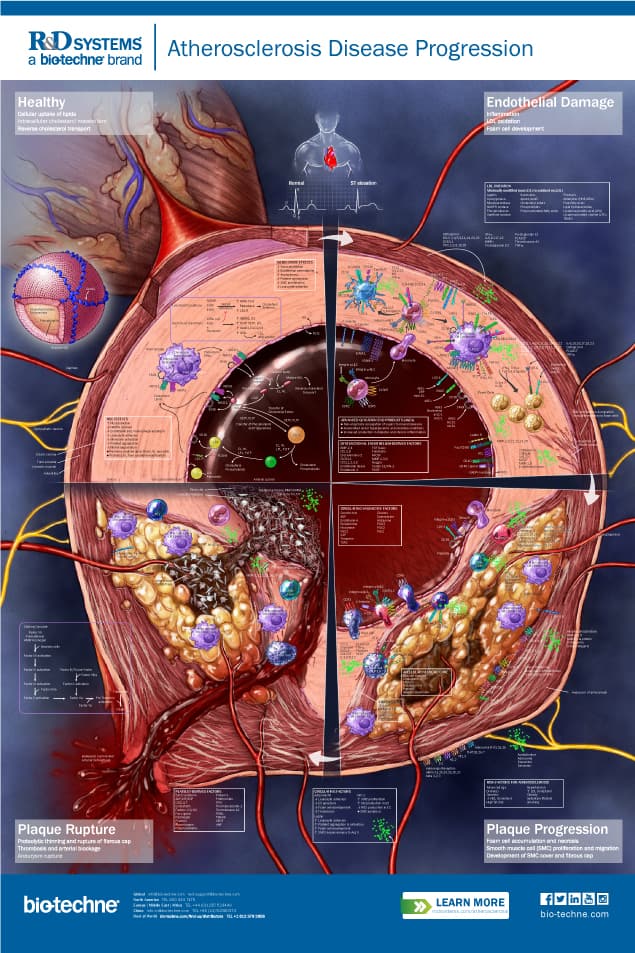New Collection of Platelet Activation Pathways
Our website has a new set of interactive pathways that outline platelet activation, with each pathway focusing on a specific aspect of the process. Links within each pathway take you to our relevant product offerings to help you carry out the next steps in your platelet research. You’ll find recombinant proteins, antibodies, small molecules, and peptides, plus single- and multi-analyte immunoassays. Once you start clicking through our pathways, you’ll find some great tools and maybe some new ideas, too.
To navigate the pathways, click on the blue tabs at the left. They allow you to jump from one pathway to another. You can browse our complete collection of pathways here.
- The overview pathway is just that - it gives a quick summary of major features of platelet activation.
- Two pathways cover molecules expressed on the surface of resting platelets including GPCRs plus immune, peptide, and adhesion receptors.
- One pathway shows the interaction of platelet adhesion receptors with their circulating and matrix-associated ligands.
- Four pathways cover signal transduction through key receptors. One of these shows inhibitory signaling which is critical for maintaining platelets in a resting state.
- The final tab is granule release. This one focuses on the contents of dense granules, lysosomes, and alpha granules. There are so many granule molecules that we thought it made sense to present it as a table instead of as a graphic!
Platelets circulate in the blood in a resting state until they encounter an activation trigger. This could be certain prostaglandins, adrenergic ligands, 5-HT/serotonin, adenosine, or inflammatory factors. In addition, molecules in the subendothelial matrix are normally shielded from circulating platelets by the intact vascular endothelium. In the event of endothelial barrier breakdown, platelets gain access to these molecules and become activated.
Upon their first exposure to activating signals, platelets rapidly upregulate adhesion proteins and stick to the damaged endothelium or to circulating leukocytes. Adhesion accelerates platelet activation and induces the release of intracellular granules that are stockpiled in resting platelets. The granules contain a large variety of molecules that regulate thrombosis (coagulation), inflammation, and wound healing. Aggregated platelets themselves serve as an important component of clots.
Platelet activation is critical for stopping blood loss. Because they circulate in high numbers and are constantly in contact with the vascular endothelium, platelets are ideally suited for sensing damage to blood vessel walls. Their activation is extremely rapid and includes several positive feedforward loops. This helps to ensure that once platelet activation begins, it will continue as fast as possible to halt blood vessel leakage. There’s no time to spare if you’re bleeding!
The regulation of this system is a high-stakes balancing act with serious risks if the balance tips too far in either direction. Exaggerated platelet activation can result in blood vessel blockade and loss of nutrient supply to healthy downstream tissues. This is a life-threatening problem in heart attack, stroke, and deep vein thrombosis. Anti-platelet or anti-thrombotic treatment is common for patients who have survived one of these episodes. Platelet deficiencies or coagulation disorders (like hemophilia) are also dangerous and can result in uncontrolled bleeding. Platelet infusion is often required to control bleeding in these people or in surgical and cancer patients. That’s why it’s so important for healthy people to donate platelets!
For additional information, please visit these related links on our website.
Platelet Resources - platelet-related products, literature, protocols, and troubleshooting guides.
Platelets research area - topic-oriented organization of our relevant products
Coagulation research area - topic-oriented organization of our relevant products
Coagulation interactive pathway and brochure - website or print outline of this very complex cascade.
Coagulation resources - coagulation-related products, literature, protocols, and troubleshooting guides.
Bioactivity of coagulation proteins - listing of our bioactive proteins plus select data examples
Don’t miss our eye-catching poster of Atherosclerosis Disease Progression and an interactive cell markers tool based on the poster.

